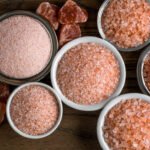Pink Himalayan Salt Vs Sea Salt
There are many types of salts that originate from different regions of the world and are known by their respective sources. The main use of salt is to season food and it is necessary for the better functioning of many functions in the human body.
Different types of gourmet salts are used for different purposes. This diversity in use is due to the specific features that make them suitable for certain use. Here, we will specifically discuss the two most popular salts – Pink himalayan salt and sea salt.
Differences Between Himalayan Salt And Sea Salt
Despite having the same main constituting compound sodium chloride, Himalayan pink salt and sea salt not only have different colors, textures, and mineral content but are also obtained differently.
As the name suggests Himalayan rock salt is sourced from underground salt mines, whereas, sea salt comes from seawater. These two salts are different from each other in many terms that make them distinct from each other.
We will discuss the key differences between these two salts based on their overall profile and characteristics.
Himalayan Pink Salt
Being the purest salt and containing more than 80 trace minerals exactly the number found in the human body, it is no wonder that pink Himalayan salt is the go-to salt for daily intake by health-conscious people all around the world.
This vibrantly pink rock salt with traces of iron is hand-mined from the salt deposits found in the foothills of the Himalayan mountain region located in Pakistan. It has a distinct flavour because of its unrefined nature and complex mineral content.
- Himalayan rock salt contains traces of iron oxide that give it a distinctive light to dark pink shade.
- Contains 84 trace minerals and elements like zinc, potassium, magnesium, sulfate, iron, and calcium.
- Adds a unique texture and subtle flavour to foods.
- Himalayan rock salt has a great tolerance for low and high temperatures which is why it is an amazing cooking and grilling block for foods.
- Can be used for curing and preserving meat.


